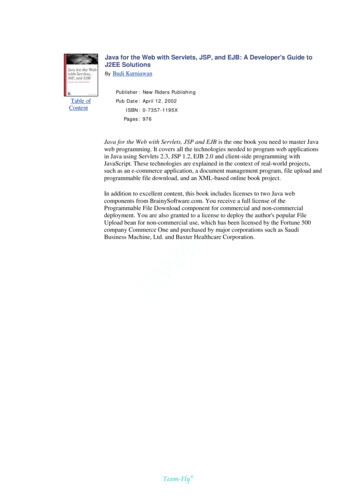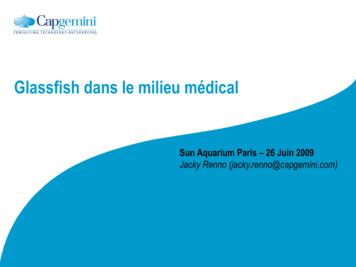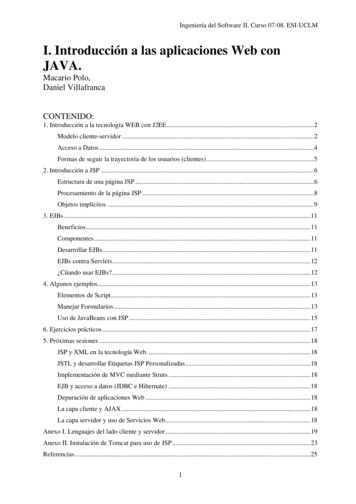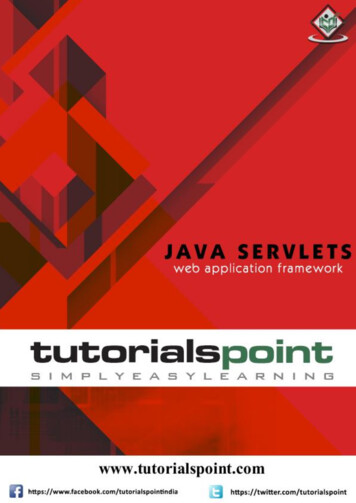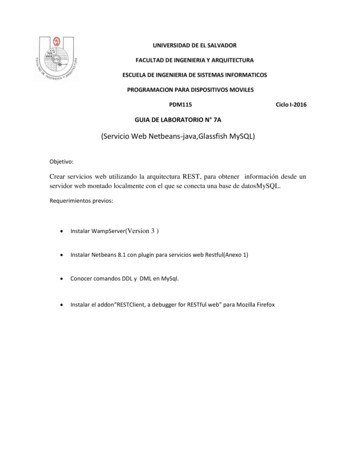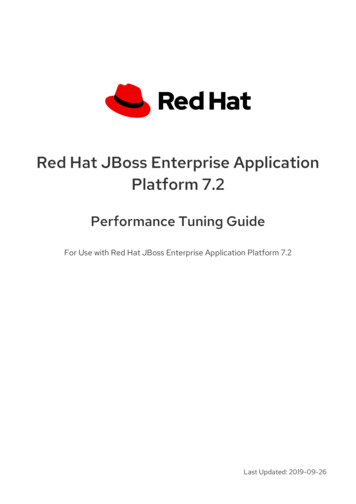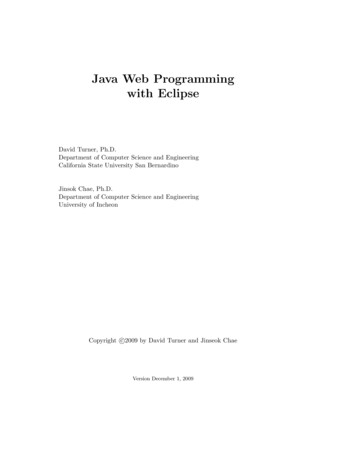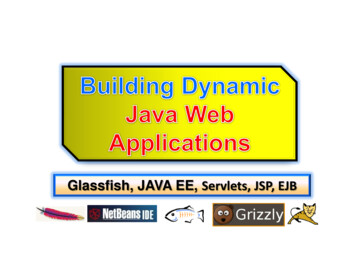
Transcription
Glassfish, JAVA EE, Servlets, JSP, EJB
Java platform A Java platform comprises the JVM together with supportingclass libraries.Java 2 Standard Edition (J2SE) (1999) provides core libraries for data structures, xmlparsing, security, internationalization, db connectivity, RMIJava 2 Platform, Enterprise Edition (J2EE) provides more class libraries for servlets, JSPs, EnterpriseJava Beans, advanced XMLJava Platform, Enterprise Edition (Java EE) When Java Platform 5.0 was released (2004) the ‘2’ wasdropped from these titles.
Java platform A Java platform comprises the JVM together withsupporting class libraries.Java Micro Edition (Java ME) comprises the necessary core libraries and tools forwriting Java for embedded systems and other smallfootprint platforms, along with some specialisedlibraries for specific types of device such as mobilephones.
Java Web ApplicationA Java web application generates interactive webpages containing various types of markup language(HTML, XML, and so on) and dynamic content.It is typically comprised of web components such as: JavaServer Pages (JSP) Servlets JavaBeansto modify and temporarily store data, interact withdatabases and web services, and render content inresponse to client requests.https://grizzly.dev.java.net/
Java EE (Enterprise Edition)Java EE (Enterprise Edition) is a widely usedplatform containing a set of coordinatedtechnologies that significantly reduce the cost andcomplexity of: developing deploying and managingJava EE 6 is supportedonly by the GlassFishserver v3.x.multitier, server-centric applications.Java EE builds upon the Java SE platform andprovides a set of APIs (application programminginterfaces) for developing and running portable, robust,scalable, reliable and secure server-side .html
Java EE 6 Platform The Java EE platform uses a simplifiedprogramming model. XML deploymentdescriptors are optional. Instead, a developercan simply enter the information asan annotation directly into a Java source file,and the Java EE server will configure thecomponent at deployment and runtime With annotations, you put the specificationinformation in your code next to the programelement ial/doc/bnaaw.html
Java EE application model an architecture for implementing services asmultitier applications that deliver the scalability,accessibility, and manageability needed byenterprise-level applications. With this structure you can more easily change oneof the tiers without compromising your entireapplication. Business and presentation logic - to be implementedby the developer Standard system services – to be provided by theJava EE al/doc/bnaaw.html
Java Servlets Servlets are Java classes that dynamicallyprocess requests and construct responses. Server side replacement for CGI Extensions to Java enabled web-servers Inherently multi-threaded. One thread per request. Very efficient. Platform independent.
How do Servlets work? Servlets run inside a Web Container - thecomponent of the web server that runs andinteracts with Servlets Servlet is running on the server listening forrequests When a request comes in, a new thread isgenerated by the web container.
Java EE ContainersJava EE containers are the interface between a Java componentand the low-level platform-specific functionality(i.e. transaction and state management,multithreading, resource pooling, etc.) thatsupports the component. provide for the separation of business logic fromresource and lifecycle management. this allows developers to focus on writing business logicrather than writing enterprise infrastructure.The Java EE platform uses "containers" to simplify work/java/javaee/javaee-faq-jsp-135209.html#diff
Java EE ContainersWhen a request comes in: a Servlet needs to be instantiated and create a new thread tohandle the request. call the Servlet’s doPost()or doGet() method and pass theHTTP request and HTTP response objects get the request and the response to the Servlet manage the life, death and resources of the Servlet* All of the above are the tasks of the web container.
Java EE ContainersJava EE SERVERFrom Bodoff et. al. 2005
Recall: (PHP-MySQL) Server: response Webserver supports HTTP.ServerWebserverHTTPClientMy codesHTMLMySQLOperating terpreter
Historically (Java Web App)Server: response Webserver supports HTTP.ServerGET.GET.Web serverHTTPClientWebbrowserWebContainerApplication html head /head body . body /html (Java code) html head /head body . body /html Servlet(Java code)Operating SystemTCP/IPOperatingSystemInternetIt’s the Container that givesthe Servlet the HTTP requestand response, and it’s theContainer that calls the Servlet’smethods (e.g. doPost() or doGet())
Historically (Java Web App)Server: response Webserver supports HTTP.ServerGET.Web serverGET. html head /head body . body /html ServletHTTPClientWebbrowser(Java code) html head /head body . body /html Operating SystemTCP/IPOperatingSystemInternetIt’s the Container that givesthe Servlet the HTTP requestand response, and it’s theContainer that calls the Servlet’smethods (e.g. doPost() or doGet())
(Java Web App) Server: response Webserver supports HTTP.ServerGET.Grizzly is now theHTTP front end ofthe applicationserverWeb server Container html head /head body . body /html ServletHTTPClient(Java code)Operating s the Container that givesthe Servlet the HTTP requestand response, and it’s theContainer that calls the Servlet’smethods (e.g. doPost() or doGet())
Java ServletsJava Servlets simplify web development by providinginfrastructure for component, communication, andsession management in a web container that isintegrated with a web server. Writing Servlets is like writing Java codes that place anHTML page inside a Java class (this is the worst part ofServlets!) (Historically!) requires a deployment descriptor (DD).This is in the form of an XML file. Servlets do not have a main() method. Servlets are under the control of another Javaapplication called a vaee/javaee-faq-jsp-135209.html#diff
JavaBeans manage the data flow between the following:Client/DatabaseServerapplication client or appletcomponents running on theJava EE serverdatabaseServer components JavaBeans components are not considered Java EEcomponents by the Java EE specification. JavaBeans components have properties and have get andset methods for accessing the properties.
Enterprise JavaBeans (EJB)Enterprise JavaBeans container handles: distributed communication threading scaling transaction management, etc.has a new packaging! (see figure)New EJB 3.1 PackagingOlder EJB epdivejavaee6glassfishv3-jsp-138230.html
create a simple web application using NetBeans IDE deploy it to a server, and view its presentation in a browser
NetBeans A 3rd party Java Integrated Development Environment(IDE)Class libraries for Servlets,JSPs, Enterprise JavaBeans, advanced XML Comes with Java EE class libraries bundled with GlassFish Sever Open Source Edition Can deploy servlets, JSPs, and web services
A Quick Tour of the IDE (v.6.9)JSP, Java Bean, User-defined Java Class & Package,Get Method, User Interface
Sample ProjectIndex.jspMain interface, Html with formInvokes response.jsp throughform action.NameHandler.javaClass NameHandlercontaining user dataresponse.jspGenerates the server’s responseDefines a JavaBean to connect the class NameHandler tothe user’s input via a form text field (name).
Creating a new Web ApplicationNew Project / Java Web
Creating a new Web ApplicationSpecify Project Name
Creating a new Web ApplicationGlassFish ServerWeb profile
Java Application Server: GlassfishGlassFishis an open source application server project ledby Sun Microsystems for the Java EE platform. Theproprietary version is called Oracle GlassFishEnterprise Server. GlassFish is free softwareSun is the original creatorof TomcatIt uses a derivative of Apache Tomcat as the servletcontainer for serving Web content, with an addedcomponent called Grizzly which uses Java NIO forscalability and re the advent of the Java New I/O API (NIO), threadmanagement issues made it impossible for a server toscale to thousands of users
Java Application Server: GlassfishGlassFish is an open source (full) application server projectled by Sun Microsystems for the Java EE platform. Theproprietary version is called Oracle GlassFish Enterprise Server.GlassFish is free software.It uses a derivative of Apache Tomcat as the servlet containerfor serving Web content, with an added component called Grizzlywhich uses Java NIO for scalability and speed.On 25 March 2010, soon after theacquisition of Sun Microsystems, Oracleissued a Roadmap for versions 3.0.1, 3.1, 3.2and 4.0 with themes revolving aroundclustering, virtualization and integration withCoherence and other Oracle h
Glassfish vs. TomcatNot a fullapplicationserverSun is the original creatorof TomcatHistorically, if you wanted to get good HTTP performancefrom Tomcat you really needed to have an Apache webserver to sit in front of Tomcat which involved more settingup and extra administrative work.Since GlassFish v1 (May 2006), Grizzly is the HTTPfrontend of the application server.It's a 100% Java NIO framework that provides the sameperformance as Apache, only it's written in Java andintegrated straight into the application d-tomcat-whats-the
Other Java web application-capableServers Blazix from Desiderata Software (1.5Megabytes, JSP, Servlets and EJBs) TomCat from Apache (Approx 6 Megabytes) WebLogic from BEA Systems (Approx 40Megabytes, JSP, Servlets and EJBs) WebSphere from IBM (Approx 100 Megabytes,JSP, Servlets and EJBs)http://www.jsptut.com/Getfamiliar.jsp
Commercial Deployment Oracle GlassFish ServerOracle provides software support onlyfor Oracle GlassFish Server, not forGlassFish Server Open Source Edition– delivers a flexible, lightweight and extensible Java EE6 platform. It provides a small footprint, fully featuredJava EE application server that is completelysupported for commercial deployment and is availableas a standalone offering. Oracle WebLogic Server– designed to run the broader portfolio of Oracle FusionMiddleware and large-scale enterprise applications.– industry's most comprehensive Java platform fordeveloping, deploying, and integrating s/doc/821-1751/gkbtb?l en&a view
Creating a new Web ApplicationJSP File
Creating a new Web ApplicationSample Run
Project: HelloWeb
HelloWeb: Directories and Files
NameHandler.java
Java PackageRight-click Source Packageshttp://en.wikipedia.org/wiki/GlassFish
Java PackageAdd a Java Class, specify Package nameJava Package a mechanism for organizing Java classes into namespaces can be stored in compressed files called JAR files, allowing classes todownload faster as a group rather than one at a time.http://en.wikipedia.org/wiki/GlassFish
Java PackageAdd a Java Classhttp://en.wikipedia.org/wiki/GlassFish
Java PackageEdit the Java Class Declare a String variable inside theclass declaration.String name; Add a constructor to the class:public NameHandler() Add the following line in theNameHandler() constructor:name null;http://en.wikipedia.org/wiki/GlassFish
Generating Getter and Setter MethodsRight-click name field in the Source editorSelection: Name Field / Refactor / Encapsulate Fields
Generating Getter and Setter MethodsNotice that Fields' Visibility is by default set to private, and Accessors'Visibility to public, indicating that the access modifier for class variabledeclaration will be specified as private, whereas getter and settermethods will be generated with public and private modifiers, respectively.
Generating Getter and Setter MethodsSelect the Refactor button.
Results of RefactoringNotice that the variabledeclaration has changed. set to privateGet and set functionswith implementation havebeen added as well. access modifier: public
Adding and Customisinga Form, input text field,submit button
Inserting a FormInvoke the palette: from the menu, select (Window/Palette): or pressCtrl Shift 8expand HTML Forms
Inserting a Formexpand HTML Forms and drag a Form item to a point after the h1 tags in the Source Editor.The Insert Form dialog box displays.
Specifying an actionSpecify the following values:Click OK.
Source GeneratedAn HTML form is automatically added to the index.jsp file.
Adding an Input Text FieldDrag a Text Input item to a point just before the /form tag, thenspecify the following values: Name: name Type: text
Source GeneratedInput Text Field
Adding a Submit ButtonDrag a Button item to a point just before the /form tag. Specify thefollowing values: Label: OK Type: submitClick OK. An HTML button is added between the form tags.
Adding some extra labels, tidying up your codeType Enter your name: just before the first input tag, thenchange the default Hello World! text between the h1 tagsto Entry Form.Right-click within the Source Editor and choose Format(Alt-Shift-F) to tidy the format of your code.
index.jsp: Source GeneratedWe would like topass this to ourserver
response.jsp
Adding a JSP FileIn the Projects window, right-click the HelloWeb project node andchoose New JSP. The New JSP File wizard opens.Name the file response, and click Finish.Notice that a response.jsp file node displays in the Projects windowbeneath index.jsp, and the new file opens in the Source Editor.
JSP Source File Generated: response.jsp
Adding a Use Bean itemIn the Palette to the right of the Source Editor, expand JSP and drag aUse Bean item to a point just below the body tag in the SourceEditor.The Insert Use Bean dialog opens.Specify the values shown in the following figure.The class NameHandlerbelongs to the packagewe have set earlier
JSP Source File Generated: response.jspNotice that the jsp:useBean tag is added beneath the body tag.
Adding a Set Bean property itemDrag a Set Bean Property item from the Palette to a point just beforethe h1 tag and click OK.In the jsp:setProperty tag that appears, delete the empty valueattribute and edit as follows. Delete the value "" attribute if the IDEcreated it! Otherwise, it overwrites the value for name that you pass inindex.jsp.
Adding a Set Bean property itemDrag a Set Bean Property item from the Palette to a point just beforethe h1 tag and click OK.In the jsp:setProperty tag that appears, delete the empty valueattribute and edit as follows. Delete the value "" attribute if the IDEcreated it! Otherwise, it overwrites the value for name that you pass inindex.jsp.
Adding a Get Bean property itemDrag a Get Bean Property item from the Palette and drop it after thecomma between the h1 tags.Specify the following values in the Insert Get Bean Property dialog: Bean Name: mybean Property Name: nameInsert a Get Bean Propertyitem here!
JSP Source Code Generatedthe user input coming from index.jsp becomes a name/value pair thatis passed to the request object.When you set a property using the jsp:setProperty tag, you canspecify the value according to the name of a property contained in therequest object.Therefore, by setting property to name, you can retrieve the valuespecified by user input.
Sample RunUser inputResponse fromthe JSP file
Sample RunIndex.jspMain interface, Html with formInvokes response.jsp throughform action.User inputNameHandler.javaresponse.jspResponse fromthe JSP fileClass NameHandlercontaining user data, get andset methodsGenerates the server’s responseDefines a JavaBean to connect the class NameHandler tothe user’s input via a form text field (name).
ProjectIndex.jspMain interface, Html with formInvokes response.jsp throughform action.NameHandler.javaClass NameHandlercontaining user data,get and set conventions.htmlresponse.jspGenerates the server’s responseDefines a JavaBean to connect the class NameHandler tothe user’s input via a form text field (name).
Packaging Web ApplicationsThe Java EE specification defines how the webapplication can be archived into a web applicationarchive (WAR) WAR files are– Java archives with a .war extension– Packaged using the same specification as zip files– Understood by all Java EE compliant applicationservers WAR files can be directly deployed in servletcontainers such as Tomcat
NetBeans WAR files To make a WAR for your NetBeans project, right click onthe project node and select Build Project. The WAR file will be placed in the “dist” sub-directoryof your project folder
ProjectJava EE Recommended Directory Structure for Simple Database p.htmlE-Commerce ommerce/data-model.html#createERDiagram
http://dot.netbeans.org:8080/AffableBean/
Model-View-Controller Paradigm
Java EE (Enterprise Edition) is a widely used platform containing a set of coordinated technologies that significantly reduce the cost and complexity of: developing deploying and managing multitier, server-centric applications. Java EE builds upon the Java SE platform and provides a set of APIs (application programming
